#khanith
Explore tagged Tumblr posts
Text
Mukhannath
Mukhannath/مخنثون (plural: Mukhannathun) was a gender & sexual-diverse community of Pre-Islamic & Classical Islamic Societies. Transgender & gender variant identities & practices are diverse and vary across different cultures and societies, including within Muslim communities. In Classical Arabia, these people were refer to as 1.)Effeminate men, 2.) people of ambiguous sexual characteristics and gender non-confirmity, who appeared as more feminine, 3.) who socially had roles typically played by women. There is no monolithic interpretation or understanding of gender identity or expression within Islam, as the religion encompasses a wide range of beliefs and cultural contexts. The existence of mukhannathun has been acknowledged in many historical islamic texts, and their status within Islamic society has been subject to varying interpretations.
Etymology
According to the lexicographers, the term mukhannath derived from the verb Kha-na-tha in the first form means to fold back the mouth of a waterskin for drinking. Derived term develop the basic idea of bending or folding in the direction of pliability,suppleness,languidness,tenderness& delicacy.
According to 9th century Arabic scholar, philologist Abn Ubayd mukhannathun were so called on their account of effeminacy (takassur, elsewhere usually paired with tathanni,suppleness).[citation needed]
Later lexicographers define the term mukhannath as a man who resembles or imitates as woman in the languidness of his limbs or the softness of his voice.This definition rose to prominence among Islamic scholars until medieval times, when the term became associated with passive homosexuality.
While the term "Mukhannath al-Jins" has been used to refer to individuals who do not conform to traditional gender norms associated with their assigned sex.
History
Pre-Islamic Arab Society:
Mukhannathun's gender expression & existence were much tolerated in Pre-Islamic Arab world.Mukhannathun from the city of Medina (Saudi Arabia), are frequently mentioned in the hadith literature & in the works of many Early Arabic and Islamic writers.Mukhannaths were used as domestic worker,domestic helper,hairdresser in the early days of Islam.Mukhannath were allowed to access in both male & female quarters.Al-'Ayni quotes from al-Tabarani that in the days of the Prophet Muhammad,the mukhannathun spoke languidly,dyed their hands and feet (with henna), but were not accused of immoral acts (fahisha).
In the Rashidun and Umayyad caliphates, various mukhannathun of Medina established themselves as celebrated entertainers,artists.One particularly prominent mukhannath, Abū ʿAbd al-Munʿim ʿĪsā ibn ʿAbd Allāh al-Dhāʾib, who had the Arabic name Ṭuwais ("Little Peacock"), was born in Medina on the day Prophet Muhammad died (8 June 632).
Ṭuwais is described as the first mukhannath person to perform "perfect singing" characterized by definitive rhythmic patterns in Medina.He was also known for his sharp wit and his skill with the tambourine (which had previously been associated only with female musicians).No sources describe his sexuality as immoral or imply that he was attracted to men.But it is reported that he was married with a woman.
While Ṭuwais is typically described as the leading mukhannath musician of Medina during his lifetime.Another Mukhannath who was known by the name al-Dalāl ("the Coquettish") is mentioned as one of Ṭuwais's favorite pupils.He is portrayed as a witty but sometimes crude man who "loved women," but did not have sex with them.Unlike Ṭuwais, some tales involving al-Dalāl do suggest that he was attracted to men.Furthermore Ṭuwais and other mukhannathun musicians formed an intermediary stage in the social class most associated with musical performance: women in pre-Islamic Arabia, mukhannathun in the Rashidun and early Umayyad caliphates, and mainly non-mukhannath men in later time periods.
In the early Umayyad period, Mukhannathun enjoyed an exceptional visibility and prestige in Medina & Mecca.Religious persecution of mukhannathun first started at the reigns of Caliph Marwan I. The governor of Mecca serving under al-Walīd I “issued a proclamation against the mukhannathun”, in addition to other entertainers. Two mukhannath musicians named Ibn Surayj and al-Gharīḍ are specifically referred to as being impacted by this proclamation. Mukhannath al-Gharīḍ fled to Yemen and never came back to Saudi Arabia.The most severe instance of persecution is typically dated to the time of al-Walīd I's brother and successor Sulaymān ibn ʿAbd al-Malik, (7th caliph of the Umayyad caliphate).According to several variants of this story, the caliph Sulayman ordered the full castration of the mukhannathun of Medina.Some versions of the tale say that all of them were forcefully undergo the castration procedure. Consequently, mukhannath or queer folks of Medina & Mecca begin to fade from historical sources, and the next generation of singers and musicians had few mukhannathun in their ranks.
Abbasid Period
During the Abbasid caliphate, the word itself was used as a descriptor for men who are entertainer and submissive or effeminate gay.Mukhannath were employed as dancers, musicians, comedian & guards of Abbasid harems.In later eras Mukhannath term has been mostly associated with effeminate homosexuality.
Safavid Period
Safavid Dynasty (1501–1736) was a Twelver Shia dynasty of Iran.Mukhannathun also appeared in Safavid Era.
Acceptance of transgender and gender non-conforming individuals within Islam can be highly influenced by cultural, social, political & regional factors. Different Muslim majority countries & communities may have differing attitudes towards gender identity and expression, ranging from acceptance to stigmatization.
Hadith Literature
Almost all references of ahadith literature justifies animosity toward queer people & have been quoted out of context; Islamic clerics,scholars wrongly condemn trans folks, despite so many major Islamic scholars having argued that the Hadith actually refer to cross-dressers (who want to deceitfully gain access to women’s spaces).
According to Sahih Bukhari 4324, Narated by Umm Salama narrated that ''Prophet (ﷺ) came to me while there was an mukhannath (Hit) sitting with me, and I heard him (i.e. the effeminate man) saying to `Abdullah bin Abi Umaiya, "O `Abdullah! See if Allah should make you conquer Ta'if tomorrow,then take the daughter of Ghailan (in marriage) as (she is so beautiful and fat that) she shows four folds of flesh when facing you, and eight when she turns her back." The Prophet (ﷺ) then said, "These (effeminate men) should never enter upon you (O women!)."
Al-Tabari (1978) took it as an example that the Prophet did not forbid a particular mukhanath, Hit, from entering the women’s quarters until he heard Hit giving a description of the women’s bodies in great detail.Hit was later prohibited from the house because ze had breached the trust of the Prophet, but not because of her gender identity or expression.According to Dr. Scott Siraj Kugle the mukhannath hadiths were so grossly taken out of context by many muslim conservatives,that what appeared to be a prophetic wisdom of protecting and sanctifying the privacy of women’s spaces; devolved into a punitive condemnation of gender & sexual diversity.
Its also known that Prophet Muhammad protect a Mukhannath (or trans woman) from death sentence.
According to a Sunan Abu Dawud 4910,narrated by Abu Hurayrah that,
''A mukhannath who had dyed his hands and feet with henna was brought to the Prophet (ﷺ).He asked: What is the matter with this man? He was told: "Messenger of Allah! He imitates the look of women." So he issued an order regarding him & he was banished to an-Naqi. The people said: Messenger of Allah! Should we not kill him? He said: I have been prohibited from killing people who pray.
According to Abu Usamah said: Naqi' is a region near Medina and not a Baqi ''.
According to Progressive Muslim scholar Mahdia Lynn, ''One group interprets this hadith as a transgressor banished: this person being sent away clearly teaches us that gender diverse people are not welcome in the Prophet’s community. According to this interpretation, living out the prophetic example today means that excluding gender and sexual diversity from Islam is right and good.
Another group looks at this story and sees a life saved: it’s clear there was a group of men ready to murder this person and so the Prophet saved their life by sending them away (to an-Naqi, a location between Mecca and Medina, which is interpreted to mean “within the bounds of Islam”). Living out prophetic example means not only accepting gender & sexual diversity as a valid part of the ummah, but being called upon to protect LGBTQI+ Muslims.''
Opinions
Within Islamic history and scholarship, there have been discussions and debates surrounding gender identities and expressions that transcends the gender binary.In the pre-modern period, muslim societies were aware of several gender non-confirmities: this can be seen through figures such as the khaasi (eunuch), the hijra (non-binary,trans), the mukhannath (trans-feminine),the mutarajjilat (trans male), the mamsuh (agender),the bissu (non-binary, polygender),the sida-sida (bigender) and the khuntha (intersex). Some Islamic scholars have explored the concept of "mukhannathun," which actually refers to individuals assigned male at birth but who exhibit feminine characteristics or behaviors.
Several scholars such as Mehrdad Alipour (2017) & Everett K. Rowson (1991) point to references in the Hadith to the existence of mukhannath: a man who carries femininity in his movements,in his appearance, and in the softness of his voice.Western scholars Aisya Aymanee M. Zaharin & Maria Pallotta-Chiarolli see the term mukhannath as referring to men who are behave like women,but do not want to undergo sex reassignment surgery,in contrast to transgender or intersex people.
Mukhannath term may use as an umbrella term for gender & sexual diverse.While sometimes Mukhannath classified as transgender people,the Mukhannathun as a group do not neatly fit into the western categories of gender or sexuality.There was too much variety from one Mukhannath to the next to establish a specific label for their gender or sexual identity, & the meaning of the term has changed over time.The Arabic term for a trans woman is Mukhannith, as they want to change their sex, while mukhannaths presumably don't.
In Popular Culture
Books
The Effeminates of Early Medina - Everett K. Rowson
Homosexuality,Transidentity and Islam -Ludovic Ahmad Zahed
Before homosexuality in Arab-Islamic World - Khaled El-Rouayheb
Sexual Ethics and Islam - Kecia Ali
Living Out Islam:Voices of Gay, Lesbian & Transgender Muslims - Scott Siraj Kugle
Homosexuality in Islam:Critical reflection on gay, lesbian & transgender muslims - Scott Siraj Kugle
Que(e)ring Religion:A Critical Anthology - Gary David Comstock, Susan E. Henking
Islam and Homosexuality - Samar Habib [volume 1], [volume 2]
Sexual and Gender Diversity in Muslim World - Vanja Hamzić
Islamic Homosexualities - Stephen O. Murray, Will Roscoe
Islamicate Sexualities:Translations across Temporal Geographies of Desire - Afsaneh Najmabadi,Kathryn Babayan
Queens, Eunuchs and Concubines in Islamic history - Taef El-Azhari
The Diesel (الديزل) by Thani al-Suwaidi
The Delight of Hearts - Ahmad Al-Tifashi
Governing Thirdness: State, Society and Non-Binary Identities - Muhammad Azfar Nisar
Films & TV
Allah Loves Equality - Wajahat Abbas Kazmi
Be Like Others - Tanaz Eshaghian
#gay muslim#transsexual muslim#transmuslim#queer history#queer islam#Hijra#Mukhannath#Mukhannith#khanith#transgender#non binary#genderqueer#gender ambiguity
58 notes
·
View notes
Text
Names generated from Daedric, Aurebesh, Greek and Georgian literas
Alphae Alphani Alphi Alphie Alphini Anith Arili Arill Ariloni Aurekem Auren Aureni Aurenth Auresk Auress Ayahk Ayahkem Ayev...
Banith Beshe Beshern Besk Bess Betani Betaurek Betayah Betayem Betayev Beth Bethe Bethern Bethesh Bethess Cesh Ceshe Ceshed Ceshek Ceshekem Ceshess Ceshi Ceshie Ceshini Cesk Ched Chedt Chefhe Chefhek Chefhen Chefherf Chefhesk Chefheth Chek Chekem Chen Cheni Cherekem Chern Chesh Cheshern Chesk Chess Cheta Chie Chinith Crek Crekem Cren Creni Crenth Creshed Creshini Cress Croht Cron Croni Cronith Deltani Deltau Deltayem Deltayev Dorek Dorekem Doren Dorenth Doresh Doreshe Doresk Doress Dzill Dzilon Dziloni Enthedt Enthenth Entherf Enthern Epsi Epsigma Epsili Epsill Epsiloni Eshed Eshefhe Eshen Eshi Eshie Etani Etanith Etaurek Etaya Etayem Forek Forekem Foren Forenth Foresh Foreshi Foresk Foress Gambda Gammani Ganith Ganithek Geta Getani Getaurek Getauren Getayahk Getayem Getayev Gethe Gethed Getherek Gethern Ghae Grekem Gren Greni Grenth Grenthek Gresh Greshini Gresk Gress Hani Hedt Hefhe Hefhedt Hefhek Hefhekem Hefheni Hefheren Hefhesh Hefhess Hefheta Heni Henth Herek Herekem Herenth Heresh Heresk Hern Hesh Heshed Heshen Hesherf Heshie Heshini Hesk Hess Heta Hetani Hetayem Hetayev Heth Hethe Hethedt Hethek Hetheta Hini Hinith Ilon Iloni Inith Iotani Iotau Iotaurek Iotayem Iotayev Iyah Iyahk Iyahkem Jeni Jenthek Jentheni Jenthesk Jenthess Kanith Kappari Kappaya Kappayah Kappayem Kappayev Khae Khanith Krek Krekem Kren Kreni Kresh Kreshi Kreshini Kresk Kress Krili Krilon Kriloni Kʼari Kʼarill Kʼarilon Lamma Lammani Lasigma Lasili Lasill Lasilon Lasiloni Leta Letani Letau Letaya Letayem Lethern Lethesk Manith Mega Megam Megambda Megamma Megani Mehk Mehkem Merek Merekem Meren Mereni Merenth Meresh Meresk Meress Merf Narili Narill Nariloni Nehk Nehkem Neni Nenth Nenthe Nentheni Nenthern Nerek Nerekem Nereni Nerenth Neresh Neresk Neress Nerf Omegam Omegamma Omegani Omehk Omeht Omerek Omeren Omeresh Omeresk Omerf Omern Omicrek Omicren Omicreni Omicresh Omicresk Omicress Omicroht Omicroni Orek Orekem Oren Oreni Orenith Orenthe Oresh Oresk Oress Parili Parill Parilon Paya Payah Payahk Payahkem Payev Peta Petani Petau Petaurek Petayem Petayev Pethed Pethekem Petherek Pethesh Pethesk Phae Phani Phie Phini Pʼani Pʼarili Pʼarill Pʼarilon Qarili Qarill Qarilon Qariloni Qekem Quambda Quamma Quammani Qʼani Qʼarili Qʼarill Qʼarilon Rekem Reni Renth Resheta Resk Ress Rhoe Roni Sanith Sehk Sehkem Seni Senthe Senthed Senthek Shed Shedt Shefhedt Shek Shekem Shenth Sherek Sherekem Sheresh Sherf Shern Shesh Shie Sigmani Sili Sill Silon Siloni Taurek Taurekem Tauresh Taya Tayah Tayahk Tayahkem Tayev Thed Thefhedt Thefhesk Thek Theni Thenth Therek Theresh Therf Thern Theth Thethed Trili Trilon Triloni Tsanith Tʼani Tʼarili Tʼarill Unith Upsi Upsigma Upsili Upsill Upsiloni Vehkem Veht Vinith Wesh Weshe Weshedt Weshie Weshini Wess Xaya Xayahk Xayahkem Xayem Xayev Xeshi Xeshie Xeshini Xesk Xess Yahk Zenith Zenth Zenthe Zentherf Zenthern Zerekem Zeren Zereni Zerenth Zeresh Zeresk Zeress Zerf Zern Zetani Zetau Zetayem Zeth Zetherf Zethern Zhae Zhanith
1 note
·
View note
Text


Mukhannath (مُخَنَّث; plural mukhannathun (مُخَنَّثون); "effeminate ones", "ones who resemble women") was a term used in Classical Arabic and Islamic literature to describe gender-variant people, and it has typically referred to effeminate men or people with ambiguous sexual characteristics, who appeared feminine and functioned sexually or socially in roles typically carried out by women.[1][2][3][4] Mukhannathun, especially those in the city of Medina, are mentioned throughout the ḥadīth literature and in the works of many early Arabic and Islamic writers. During the Rashidun era and first half of the Umayyad era, they were strongly associated with music and entertainment.[1] During the Abbasid caliphate, the word itself was used as a descriptor for men employed as dancers, musicians, and/or comedians.[5]
In later eras, the term mukhannath was associated with the receptive partner in gay sexual practices, an association that has persisted into the modern day.[6] Khanith is a vernacular Arabic term used in some parts of the Arabian Peninsula to denote the gender role ascribed to males and occasionally intersex people who function sexually, and in some ways socially, as women. The term is closely related to the word mukhannath.
The comment got reported instantly!! And i got blocked. How is this even ofenssive?
1 note
·
View note
Text
QueerHabibi: pessoas LGBT+ da Península Arábica em desenhos

"Meu projeto visa representar um nicho alvo, a comunidade LGBTQIA + da Península Arábica, que é frequentemente subestimada, e julgada como um grupo social inexistente".
Foi em janeiro de 2018 que o Queer Habibi, uma palavra carinhosa que pode-se traduzir para "queride" ou "meu amor", apareceu no Twitter e no Instagram. O objetivo deste projeto de desenho? Ilustrar, tornar visível, e normalizar as pessoas LGBT + árabes.
Uma publicação compartilhada por Queer Habibi (@artqueerhabibi) em 10 de Jan, 2018 às 9:46 PST

"Eu quero mostrar ao mundo que você pode viver em países árabes e ser queer ao mesmo tempo, e que não há mal nenhum nisso" diz em entrevista à Pink News, sob condição de anonimato, o artista do gênero masculino ao explicar sua abordagem. "Meu desejo de aumentar a conscientização me levou a criar o Art Queer Habibi para educar e informar meus seguidores sobre o fato de que existem pessoas LGBTQIA + em países árabes e no resto do mundo. "

É com grande delicadeza que a mão do artista circula os contornos dos personagens cintilantes do Queer Habibi ao longo de suas publicações.


O artista diz receber muitas mensagens de apoio e alívio das pessoas, o que faz com que tenha mais imaginação, delicadeza e dedicação. "Eu vejo que é esse senso de honra e dever que me leva a continuar, apesar das críticas, e algumas pequenas ameaças."


Queer Habibi também vem na forma de cartões postais, que são uma maneira de apoiar o projeto e espalhar a mensagem.
Fonte: Komitid
Traduzido e postado por Dani Camel
#queer habibi#árabes lgbt#queer arabs#oriente medio#middle east#saudi#koçek#bacha posh#hanithi#khawal#khanith#xanith#mukhannath#khuntha
14 notes
·
View notes
Link
Early enough in my adolescence, the internet became a social space safe enough for self-understanding and for rejecting the heteronormative possibilities of my future. Most of these online spaces were in English by default; occasionally there might be a space in Arabic, but that did not become common until later. I found myself living between the languages I spoke, at times preferring to use English, and at other times Arabic. At some point, I found an online support group for LGBT teenagers mostly in the United States, but there were members from Asunción, Paraguay and Sydney, Australia. I became accustomed to referring to myself using English terminology common in LGBT society. At some point, as I began to participate in online translation work, I tried to find people like me who described themselves in Arabic terminology, and it took a while to do so. Eventually I found a chatroom under the channel name #makhanith (in the Arabic script). There were about thirty or forty regular users. Most of them were from the Gulf Arab states. And many were there to cruise for sex, but I found it difficult to find folks in Dubai specifically, so I ended up spending most of my time there having random conversation with others. These conversations were almost exclusively in Arabic, and that is how I learned the LGBT community’s terminologies used in my variety of Arabic. These online spaces became an important part of my identity, and the name of the chatroom lent itself to that. Indeed, often when speaking in English I found myself using the usual Western terminology expected by English speakers, while in Arabic I often used khanith in self-reference as it served the purpose of signaling to Arabic speakers who rejected heteronormative possibilities who I was and how we are in relation to each other.
#queer history#lgbt history#lgbt#queer#oman#omani history#queer oman#lgbt oman#language#queer language
722 notes
·
View notes
Text
Reminder to transphobes who somehow end up on my page. While my gender lines up with the binary, this is a nonbinary safe page. Your identity is not only valid but it is NOT something that Tumblr made up.
First of all, if you support binary trans identities but not nonbinary or gender nonconforming identities, you are ignoring Monica Helms (The creator of the trans flag in 1999, long before tumblr) reasoning for the white stripe in the flag.
“The stripes at the top and bottom are light blue, the traditional color for baby boys. The stripes next to them are pink, the traditional color for baby girls. The stripe in the middle is white, for those who are intersex, transitioning or consider themselves having a neutral or undefined gender."
Secondly, being nonbinary is something that has been around for thousands of years and to think otherwise is incredibly Eurocentric and blatantly ignores other cultures that have had nonbinary and third genders since antiquity. Genders such as Fa'afafine (Samoan), Hijras(Indian), Khanith (Oman), and Two-Spirit (Indigenous North American Nations) just to name a few.
As someone who has a degree in Anthropology and Gender Studies, I'm happy to take genuine questions. Just know that I support you, history supports you, and academia supports you.
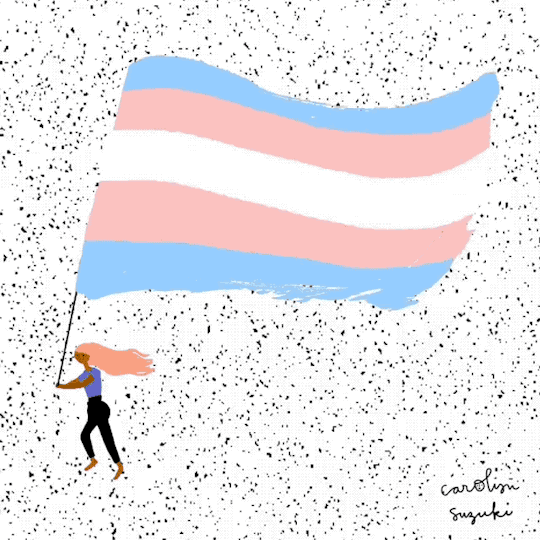
#nonbinary#transgender#anthropology#gender studies#gender noncomformity#monica helms#pride month#trans pride
11 notes
·
View notes
Photo

Khaneeth / خنيث
A vernacular Arabic term used in Oman and parts of the Arabian peninsula to refer to effeminate men who are attracted to other men. It is also used to describe a third gender, or transwomen in particular. It is a masculine word and is associated with passive, impotent, subordinate characteristics. It is used today derogatorily with the same meaning as “faggot.”
Also: Khanith, Xanith
3 notes
·
View notes
Text
Queer Glossary of Muslim/Islamic World:
This is a list of gender & sexuality related terms, used in Muslim/Islamic World.
Mithli/Mithly - postmodern Arabic term for queer folks
Mithliya - feminine form word “Mithli”, refers to lesbians, sapphics, queer women
Kwiir/Kwiiriya - arabized version of word queer
Mukhannas/Mukhannath/Mokhannas/Mukhanathan/Mukhannathin - archaic Arabic term for trans woman, trans femme, individuals of non-normative gender and/or sexuality
Mukhannith - classical Arabic term for transsexual woman
Mutarajilla/Mutarajil/Mutarajilat - archaic Arabic term for masculinized female, trans male, trans-masculine. It is masculine equivalent of word “Mukhannath”
Boyah/Boyat - a term used in persian gulf states to describe masculine women,butch, & AFAB gender non-confirming
Mustargil/Mustarjil/Mustarajil/Mustarajjila- vernacular term for trans male/trans-masculine folks in Marsh Arab tribe
Mabun/Maabun - archaic term for an eunuch homosexual male who take passive role in Islamicate World.
Khanith/Khaneeth/Xanith/Makhanith - vernacular term for AMAB transgender, gender non-confirming, queer in Arabian Peninsula. The Khanith is also a third gender/sex community of Arabian peninsula.
Khuntha/Khunsha - archaic Arabic term used to describe intersex & ambiguous gender individuals in Muslim World.
Khuntha Mushkil - term for non-binary & gender non-confirming intersex individuals.
Khasi/Khasee - archaic term for eunuchs in Arabic/MENA Islamic empires
Khusra/Khusray/Khusaray/Khusara - Pejorative word for eunuch transgender, gender non-confirming individuals in Pakistan & Northernmost India. The word derived from Punjabi
Murat/Muraat/Morat/Moorat - vernacular term for transgender, eunuch, gender-diverse folks in Pakistan. It is also used in some parts of Afghanistan.The word Murat is itself a portmanteau of Mard (meaning man) and Aurat (meaning woman)
Hijra/Hijre/Hijjara/Hijarah/Hijada – all-encompassing term for gender & sexual diverse folks in the Indian subcontinent. The term includes trans femme, mtf transsexual, masculine woman, effeminate gay man, cisgendered drag queen, androgyne, transvestite, queer, eunuch, non-binary & intersex individual
Khawaal - term for MTF transsexual, transvestite & effeminate dancers in Pre-mordern Egypt.
Köçek - archaic term for effeminate male, gender fluid dancers in Ottoman society. The term also refers to feminine boys regardless of their sexual orientation. “Cengi” is female counterpart of Köçek.
Khawaja sara/Khwaja sara/Khwaja sira/Khawaja sira/Khwajasera/Khwaja saray - Persian archaic term used to describe a range of gender identities, including trans woman, gender fluid, effeminate (mukhannas), eunuch, trans-masculine, and trans-feminine individuals in South Asia. It goes beyond being just a gender or sexual identity; it is also associated with gender spirituality. This term was historically used to designate trans and non-binary individuals in Medieval Muslim empires. Nowadays, the term khawaja sara/khwajasara has become a subset of Hijra
Kothi - pejorative slang term for effeminate men, gay transvestites, drag queen, passive homosexuals in Indian subcontinent. In pakistan, kothis are referred as “Zenana”.
Panthi - slang term for dominant, hard, masculine gay & bisexual male in Bangladesh, Pakistan & India. This term derived from to Hijra Farsi or Ulti Bhasha
Parikh/Paarikh - slang term refers to boyfriend & husband in Bangladesh. This word is mostly used among LGBTQ+ population
Dohpartaa or Dohpartah - informal, slang term for bisexual in Bangladesh & West Bengal. The word derived from the Hijra Farsi or Ulti language.
Mamsuh - Arabic term for intersex person, who is agender or genderless.
Hum Jins, Hum jinsi, Ham-jense, Ham-jens – homosexual in Urdu, Persian, Tajik language
Ham-jins bâz/Ham-jens bâz – a derogatory term for gays in Farsi-speaking communities.
Ham-jens-garâ - slurr for homosexual in Farsi
Ham-jins garo - pejorative term for homosexuals in Tajikistan
Do jens garâ/Doh jense garâ - term for bisexual in Farsi
Mak Nyah - term for transgender woman, MTF transsexual in Malaysia. The term “Mak Nyah” is widely used among trans women, mukhannath/ trans-feminine folks. The term was first coined in late 1980s.
Pak Nyah - informal,vernacular term for trans men in Malaysia.
Waria - Indonesian term for AMAB trans folks in Indonesia. Warias are considered as third gender in Indonesia.
Priawan - vernacular term for trans-masculine in Indonesia.
Bissu - a term used to describe non-binary or two spirit identity in Bugie Tribe of Indonesia
Burnesha - vernacular term used to describe trans-masculine,butch in Ottoman empire of balkan & Albania.
Chokri/Chukri - term for drag queens, transvestites who are associated with “Alcap gaan”, a sufi folk music. This cross-gender phenomenon can be found in Bangladesh & West Bengal. Chukri individuals may identify as straight, gay, bisexual, or trans. Muslim Chukris are devotee of sufi saint Madar Pir/Madari Pir.
Zenana/Jenanah - vernacular term for effeminate male,MTF transvestite in Bangladesh,Pakistan,Northern India.The term Zenana derived from Urdu or Farsi, which means feminine.
Bachaa posh - vernacular term for FTM crossdresser, trans-masculine in Afghani dialect
Bacha Bareesh - pejorative vernacular term for effeminate boy, passive homosexual,transgender folks in Afghanistan. Bacha Bareesh are effeminate boys,MTF drag queens who take part in Bacha bazi.
Bacha Nagma - a term used for sufi transvestite or drag dancers in Kashmir.
Gej – non-derogatory term for gays in Balkan regions. It is used in Bosnia & Herzegovina, Albania, Kosovo, Serbia, Macedonia, Romania.
Dygjinishëm - Albanian term for bisexual
142 notes
·
View notes
Text
So random thing that has been bothering me.
I found this series, amazing series, love it. Compelling, well written, stunning, amazing. Basically, Tales of the Arabian Nights setting, with a trans young woman as a main character. I don’t want to spoil the plot, if you want to know more of the plot, read Stealing Thunder by Alina Boyden.
There’s a straight up hijra (south Asian community term for trans woman) dynasty. No trans men. No trans masc people. No one nonbinary. But lots of trans women. And that’s fine, I want trans women to have rep. It's just that most of the books I’ve read with trans masculine characters are about teenage trans angst, and I lived through that, I don’t need to read about it.
Not entirely the point. I tried to use duckduckgo to find my way around the internet to find a trans masc equivalent for hijra. There isn’t one. Okay, let me try other cultural identities. There are a lot of cultures who have words for AMAB trans people, but nothing for trans masc people.
The closest I found, which was admittedly a really cool history fact, was Inanna. She was the most venerated Babylonian goddess, with the ability to change people’s gender. Her entire clergy was nonbinary folks, and people who presented as neither male nor female. Her temples are some of the earliest examples we have of cuneiform, or written language. Goes back to about 4000 BCE. Trans people have literally always been here.
But trans men don’t often have words. After thoroughly digging into transgender people in ancient history, I can tell you about hijras in India, kathoeys in Thailand, khanith in Arabia, nádleehi of the Navajo tribe, lhamana of the Zuni tribe, and galli priestesses in Rome, Greece, and Phrygia. All of these groups of people are immediately mentioned on the transgender history wikipedia page, where as trans masculine folks have “been referenced,” in texts.
After more digging, I can tell you that an island that is part of Indonesia, Sulawesi, has five different gender identities, including calalai, which is a term for a trans masculine person.
To be very, very clear on where I’m coming from. I’m glad trans women have words. I’m glad they have communities, and histories, and places they belong. I’m super glad this book exists, and I want to give Stealing Thunder to every single teenage trans girl I can find. Phenomenal book, phenomenal story, and a very rich cultural history. Those are all wonderful things.
My only point in comparing all of these experiences to trans men is because trans masculine history exists. We can find references for it, follow trails of bread crumbs, and sort out the “woman who dressed as a man to get ahead” and “AFAB person who dressed as a man because that’s their identity.” But I want words. I want to go back in time and figure out what words people used to identify, what words people used to find themselves.
And more than that, I’m tired of being a foot note. I’m tired of being “ah yes, you exist sometimes too!” I’m tired of feeling pushed out of my own community. I’m tired of finding these cool, amazing, wonderful books I love to reread and not seeing myself in them. Transgender men have existed throughout time. We’ve contributed to the community, been activists and caretakers and people who stood guard and advocated for safety. We’ve donated to ground breaking research, showed up to protests during the AIDS epidemic, thrown bricks at cops during Stonewall, and have otherwise contributed to and supported queer rights.
If you’re not seeing trans masculine voices, if you don’t see us in the community showing up and helping out, well. Either you’re not looking hard enough, or you’re erasing our contributions.
I refuse to continue to feel shame about the trans masculine people who predated me. I’m done believing the incomplete history I was told, that my people went full stealth, abandoned their community, and acted solely for their own self preservation. I show up when it matters. I know so many trans masculine people who show up when it matters, often thanklessly, often while being silenced on the oppression that they face in their day to day lives.
It is hard, and lonely, and I am feeling the centuries, and millennia, of gaps in my history and existence. I am tired of being erased. If you want to heal masculinity, start with the people who love it despite being punished for expressing it. Listen to trans masculine voices, and include us in the narrative of progress.
a lot y’all think it’s Peak Ally to be like “i treat trans men the same way i treat cis men uwu” but that isn’t helpful when u treat cis men like garbage bc u believe all men are biologically evil and don’t deserve basic human decency bc then guess what happens. u treat trans men like we’re evil and don’t deserve basic human decency. which, considering there’s currently a genocide being carried out against trans people (including trans men, bc ik some of y’all need to be reminded of that) in at least one country, maybe that’s like. not great!
#transgender#trans men#trans masculine#transgender history#the t is not for token#I didn't mean to write a ridiculously long essay about trans masc history#but here we are
17K notes
·
View notes
Text
Chapter Twenty-Four : T as in TRANSGENDER
Let’s run down our Queer alphabet. I did the G for sure because patriarchy. I did the L. The L was an interesting journey. Obviously, I did the B, I may have overdid it at times. Okay, are we done ? What do you mean, no ? T ? Uh ?

WHAT’S THE T ?
Transgender : denoting or relating to a person whose of sense of personal identity and gender does not correspond with their birth sex.
We previously talked about gender identity and how sometimes, it may differ from the sex you were assigned at birth. Well, still true but that’s just the basic info everyone is supposed to know about. The word transgender, coined by Psychiatrist John F. Oliven in his 1965 book Sexual Hygiene and Pathology, is actually as much an proper identity as it is an umbrella term to many variables in the Trans community. We’ll get to that in a minute.
4500 YEARS IN THE PAST (or the Unexpected Virtue of Ambitious Storytelling in a Amateurish Article)

In broad terms, the History of transgender people begins in ancient Sumerian and Akkadian civilizations, as texts from over 4500 years ago mention transgender priests and prostitutes (remember, oldest job in the world). Some reports suggest that the idea of a third gender came from prehistoric times. They were known Trans priests in Ancient Greece, Phrygia and Rome while an Roman Emperor called Elagabalus preferred the use of “lady” instead of “lord” when addressed to. Variables from the trans community umbrella comes from the fact that there is shared History between transgender people, intersex people and even Second Spirit individuals from the Navajo community. Hijras (India), Kathoeys (Thailand) and Khanith (Arabia) have importance and recognized identities when it comes to the question of gender around the world. They are reports of transitions from male to female and female to male as early as the 1800s, with musicians (Billy Tipton), soldiers (Albert Cashier) and painters (Lili Elbe) coming to terms with their identity reassignment.

Lili, in fact, is famous for becoming one of the first woman to go through vaginoplasty in 1931. She went to Germany to undergo four different operations over a period of two years. Her immune system rejected the final operation (construction of a vagina and implementation of a uterus), and her body developed an infection. She died on September 13, 1931. Her life was immortalized in 2000’s The Danish Girl written by David Ebershoff, followed by a movie adaption from Tom Hooper (2015).
To be honest, the History of Transgender people in the world is so vast and varied, I’m getting overwhelmed. The Tale of Two Brothers from Ancient Egypt. Tribes from West Africa who did not assigned gender to their children until the age of five (In Central Africa, one can be genderless until puberty). The great tradition of dan roles in China since at least the Mind and Qing dynasties. The story of Esther Brandeau/Jacques La Fargue from 18th century Canada. Frances Thompson, a formerly enslaved black trans woman, one of five to testify in front of a U.S. congressional committee in 1866. Zuni Ihamana We’wha who became a cultural ambassador of her/his people in 1896. Danica Roem… Oh Danica Roem. Remind me to talk about Danica Roem later.
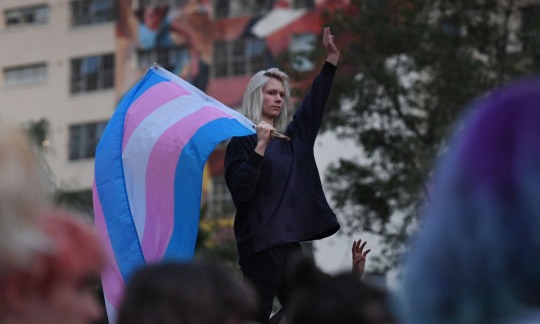
And now, it sounds like we’re not defining Trans identity properly as I’ve just mentioned Intersex and Cross-Dressing performers. Well, History is messy. Although they officially differ from one another now, they were more obscure concepts back then (and before “then” was a “then”).
DO NOT CONFUSE (PRESENT EDITION)
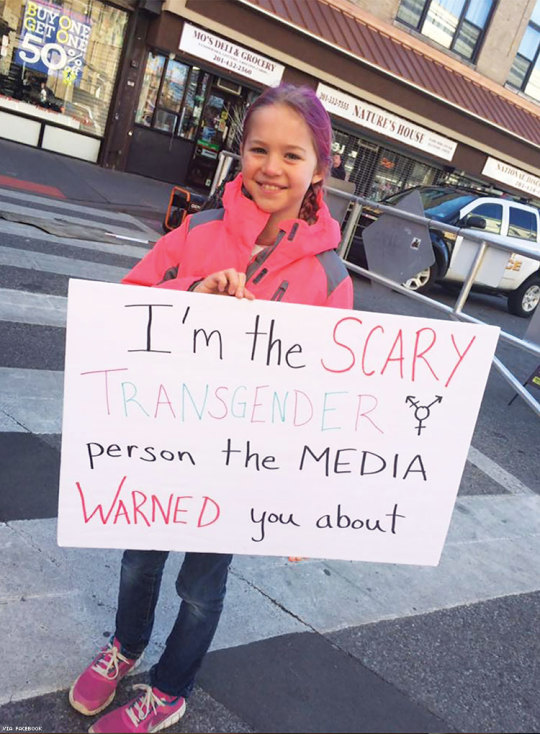
The first notion that a ignorant could have, based on lack of informations and overbearing sense of historic confusion, is that Transsexual and Transgender are synonyms. In fact, yes, Transsexual is a term that was used for a long ass time to define transgender people. It has since been rejected by a big part of the trans community. For now, transsexual is a subset of the umbrella that is Transgender. For a transgender person, the notion that “sexual” is used at to refer to their gender identity is extremely reductive. If you are still confused and one day you meet a openly out trans man or woman, don’t put your fist in your mouth flipping a coin to figure out what term suits them best. Just ask. Politely. A Transgender individual is also not to be confused with Transvestites. Transvestite : Someone who derives pleasure from dressing in clothes primarily associated with the opposite sex. First of all, transvestite is kind of an outdated term that was used in such a negative way I almost find it insulting (although it shouldn’t). Know that transvestism has nothing to do with gender identity. It’s the pleasure to put on clothes that do not belong to your gender category. A transvestite gay man stays a gay man. In some cases (but not all), the act of transvestism is developed as a fetish and provokes sexual arousal.
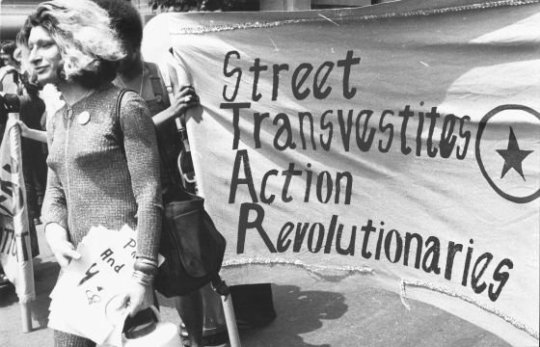
One synonym of the term would be cross-dressing, which was coined after some members of the post-Stonewall Riots group Street Transvestite ActionRevolutionaries, founded by Sylvia Rivera (1971) complained about the use of the term Transvestite. One newly-named long-lost cousin derivative of this is the term Genderfuck (or GenderBender), in which an individual will dress regardless of the binary concepts of fashion and clothing.

Do not confuse Transgender with the Art of Drag. Yes, you’re straight but hyped, you kiki in front of RuPaul’s Drag Race from time to time because they’re so funny and flamboyant. Yes. Yes. Being a Drag Queen is basically being a Cross-Dresser, except that this is a vocation, a paid job if you are lucky. Drag Queens are performers, pretty damn good ones at that, and their gender and sexual identities have nothing to do with how they pay the rent. If you read the June 11th article on RuPaul, you’ll see the details on the scandal Ru created about transgender people. Know that some Drag Queens are transgender and they can keep on being fabulous Drag Queens. Oh, and Drag Kings are a thing too. They just don’t have an Emmy Award-winning show to popularize them.
I will talk about Intersex people and their ancestry and connections to the Trans community, but not today.
PROCCESS
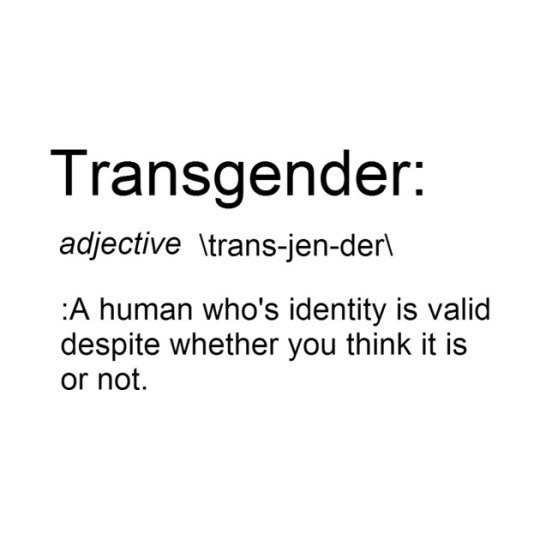

As a Transgender person, you usually feel a disconnection at a very young age between who you are in your head and what body was given to you by a non-existent God Almighty. When a person starts to go into transition (Process of changing one’s gender presentation and/or sex characteristics to accord with one’s internal sense of gender identity — the ���and/or” is crucially important) he/she/they makes a conscious personal decision. Careful, you cannot confuse Transitioning with Sex Reassignment Surgery (or SRS), which is only an option. Transitioning is a holistic process and includes many physical, psychological, social and emotional changes.
On the social side, the first step would be to come out. A gay man or woman does not simply go from one gender to another, he/she/they has to redo the entire terrible dance of announcing your gender identity. Through that process, a new name might be chosen by the individual, with the proper set of pronouns. Since it’s a process that can be years in the making, the person transitioning might start to wear different clothing and accessories, style their hair differently, ease themselves into his/her/their real self.
Whether of not he/she/they go through with SRS is totally up to the individual. In the times of Lili Elbe, you could not consider yourself a transgender person unless SRS was performed. You would have been a transvestite. Today, as the laws progressed (very slowly and very recently), only the decision and the social and psychological changes are factors into transitioning legally.

Also, if you ever wonder in a transperson went through surgery, just dont. IT’S NONE OF YOUR FUCKING BUSINESS, YOU DOUCHEFUCK.
On the medical side, the use of hormone therapy to create feminine or masculine characteristics is a major step into the transition (again, not an obligation). For trans women, surgeries can include breast implants, orchiectomy, laser hair removal, tracheal shave, facial feminization and penile inversion vaginoplasty. For trans men, male chest reconstruction, hysterectomy, phalloplasty and metoidioplasty are options to explore.
You also need a trustworthy doctor by your side to help you through your transition. Using hormones without medical guidance is dangerous and you may risk serious complications.
The point is, not all transgender people transition “completely” or even at all. The ways of some are not those of others. It may be a personal choice or a financial one, as those surgeries are very expansive and not always part of your insurance package (in the States, for example). Nevertheless, a person’s gender identity should always be respected no matter how they decide to transition socially or medically.
TRANS UNDER THE LAW

They are still a lot of places in the world where Transgender people are not protected under the law, where they cannot access the public bathroom of their gender based of bigotry ideas and religious fanaticism. There’s also discrimination in work places, many other public services, in health care.
In the United States, where you can be recognized as Trans, an Employment Non-Discrimination Act was stalled and failed several times over the last two decades. Each state now have choices of legislation in the matter. Mr. Orange is quickly taking back what was giving over the years to Trans people, such as the right to serve in the United States Armed Forces. Furthermore, Trans black women are still the most in danger population on record. As recently at early, the body of 26 year-old Chynal Lindsey was found. It’s the second unsolved murder of a trans black woman in the spam of a few weeks, fourth in three years in Dallas alone.
Did you know that until January of 2018, France was asking their transgender citizens to go through obligatory sterilization, a direct violation of human rights (decision made the European Court of Human Rights in April 2017) ? 20 countries in Europe were implementing that rule, while 36 still require mental health diagnosis in order to get legal gender recognition. Back to France. Laws to protect trans people started to be talked about as early as the late 70s. Twice, in 1981 and 1982, a law failed to pass. Meanwhile, transpeople were still considered psychiatric cases when in need of hospital care, and that until 2010. Since the 2016 case of a young trans woman who didn’t want to go through any surgery and still change her legal name, shit have moved around in the right direction. With the non-obligation to be sterilized came the possibility to change one’s name more easily, not based on any invasive medical procedures. You need to prove that that name represents your real identity, that’s it’s been used that others for quite some time and the change would harm your psychological well-being. New rules about minors who want to transition have also been add up to the law. They can change their names at age 12. The birth certificate can be modified at age 16. Transphobia is punishable through many updated laws when it comes to slurs, defamation, sexual harassment and discrimination.
And yet, trans people don’t feel safe. I wonder why.
EQUAL OPPORTUNITY NOTHING

2017 and 2018 were the deadliest years for Transgender Americans, with over 50 deaths in 24 months. Cases of Transgender people being arrested for crimes that were not crimes are basically limitless at this point. The Transgender community is still the most rejected of them all. Have you ever wondered how you would react if Pierre was suddenly in the process of becoming Vanessa, her real self ? The answer is not relevant. Vanessa would not have the support of her family, her uneducated friends would try to ditch her faster than you can say vaginoplasty and her boss would find a way to make her feel unwelcome. People have not been properly educated. They get easily confused with pronouns, so to understand the difficult process of gender dysphoria ?

Gender Dysphoria : the distress a person feels due to their birth-assigned sex and gender not matching their gender identity. My mama once told me that the fact that I was gay took time for her to process but she never stopped loving me. When I asked her “what if I was transgender ?” she replied “Oh no Alex. Not that. I don’t think I would accept that”. My mama’s no bigot. She is just so uninformed that she automatically rejects any foreign ideas. That’s why representation is so fucking important, so.
WE CAN BE HEROES

Long gone are the days where the only trans people on television were played by cisgender actors and were called “transvestite hooker #2”. It started with a bang with Hilary Swank in Boys Don’t Cry (1999), it slowly went to more recognition with Felicity Huffman in Transamerica (2005) to continue through Jared Leto in Dallas Buyers Club (2013). All fine performances by three cisgender folks. I’m not even gonna mention prior appearances of trans characters, they are just so offensive.
The real revolution started in July of 2013, when the character of Sofia, played by Laverne Cox, was introduced to the world by Netflix. A transgender character played by a transgender actress. She went on to be nominated for the Primetime Emmy Award for Guest Actress. Twice. The consecration came a year later when Cox made the cover of Time magazine. It was called a “transgender tipping point”.
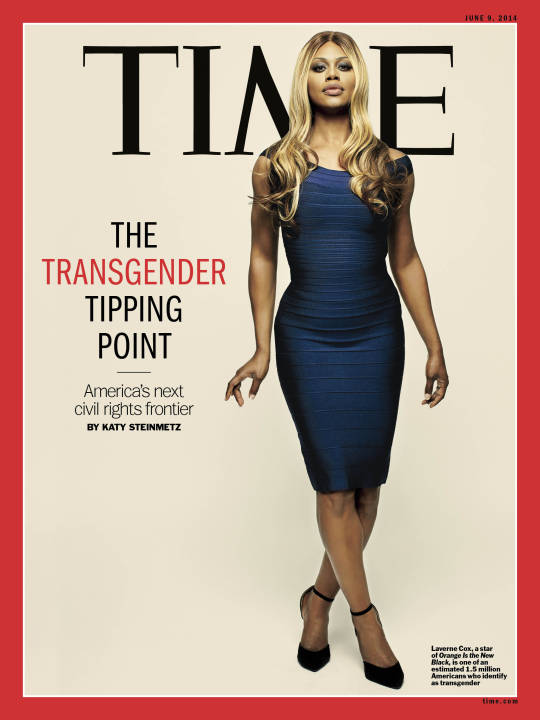
In 2014, Transparent debuted its first season on Amazon. Let’s not forget the Tambor scandal, yes, but it would be a shame to not celebrate the work of non-binary individual Jill Soloway, who gave trans people a platform — as except for Tambor and Whitford characters, all the trans characters were played by transgender people. in 2015, Caitlyn Jenner made the cover of Vanity Fair, officially announcing her transition. She’s a terrible person. I won’t say otherwise because she’s a trans women. A terrible person is a terrible person. In 2017, A Fantastic Woman won Best Foreign Film at the Academy Awards. First, it’s an incredible movie. Second, it served as a response from the government trying to erase the trans community from existence in the military. An incredibly realistic portrayal of a trans character in Shameless (played by the gorgeous Elliot Fletcher) in also to be noted.

In 2018, Pose premiered its first episode. I’ve already talked about Pose so much. I’m not getting into too much detail again. It’s major.
I’ll just say this : I went back to work on Friday. I work at an english bookstore, you see. In the press department. And There she was. Indya Moore. On the cover of Elle US. My jaw dropped on the floor. A trans woman on the cover of one of the most popular fashion magazine in the world. I’m sorry but MILESTONE.
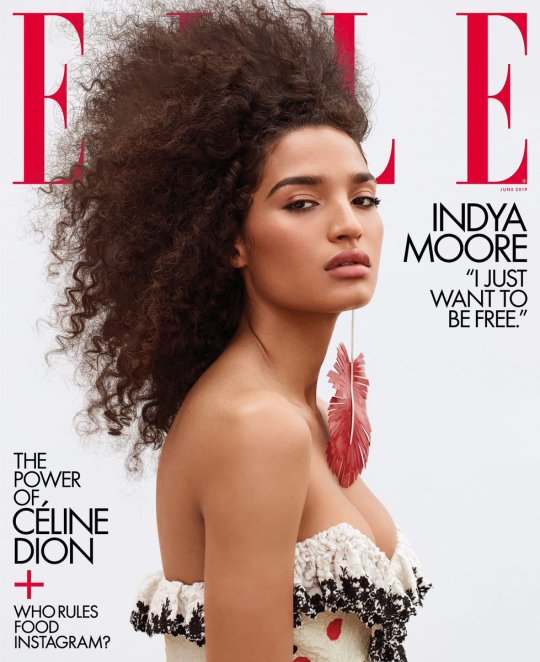
Scarlett Johansson having to quit a movie where she was gonna play a transgender person because of the outpour of rage that followed ? PRICELESS MILESTONE. Janet Mock becoming the first transgender person to direct an episode of television ? MILESTONE TO INFINITY. Supergirl just introduced the TV’s first transgender superhero, played by Nicole Maines. I’ve said it before. Get the kids on board and then, jackpot. In France, activist-turned-actor Adrian de La Vega and actor Océan (who documentary feature is available for streaming right now!) are making incredible waves for the french trans community.

My god… DANICA ROEM ! This american journalist was elected to the Virginia House of Delegates in 2017, becoming the first transgender person to both be elected and serve in any U.S. state legislature. She famously answered to a chance to attack her republican counterpart in the race (Bob Marshall, nicknamed the commonwealth’s “chief homophobe”) by these simple words : “I don’t attack my constituents. Bob is my constituent now.”
GET YOUR PRIORITIES STRAIGHT… WELL, TRANSGHT

Queer people, here’s my daily message on repeat : GIVE MORE TO THE TRANS COMMUNITY. Stop looking at yourselves in the gym mirrors and focus : Trans people be should OUR top priority. We are letting our siblings in the mud while we parade with pride. Enough. Each new Pride should be first of foremost about trans rights and how we can protect them. AS FAST AS WE CAN. Here we have brave men and women having the courage to live as their true selves, we are one of the same. No dancing on Robyn’s music until the entire crowd starts screaming “TRANS RIGHTS NOW ! TRANS RIGHTS NOW !” I’m not hearing you. LOUDER.
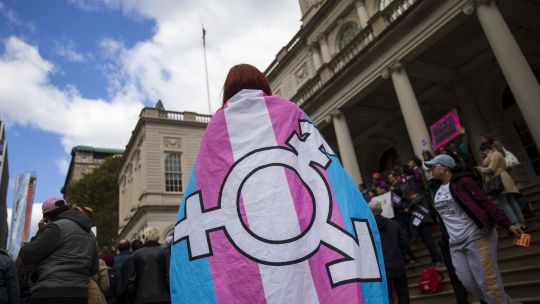
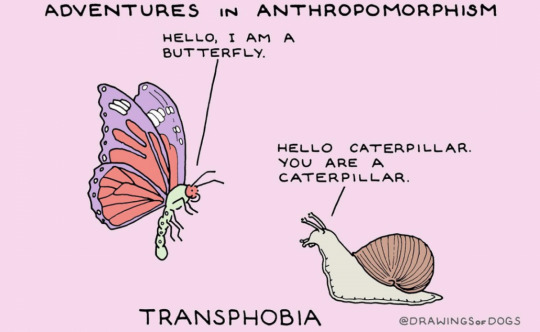
0 notes
Text
Transgender people in Islam
Mukhannathun (مخنثون "effeminate ones", "men who resemble women", singularmukhannath) is Classical Arabic, an ancient antecedent to the modern conception of transgender women, who, as time went on, were forced to be castrated. There has been significant mention of "mukhannathun" inahadith and by scholars of Islam. Outside of religious texts, they are strongly associated with music and entertainment. Khanith is a vernacular Arabic term used in Oman and the Arabian Peninsula to denote the gender role ascribed to males who function sexually, and in some ways socially, as women. The word is closely related to the word mukhannath. Mentions of Mukhannathun in the Hadith and SunnahEdit There are many references to the mukhannathun, both directly and indirectly, in the hadith and sunnah. A hadith is Sunan Abu Dawud 41, 4910: A mukhannath who had dyed his hands and feet with henna was brought to the Prophet. He asked: What is the matter with this man? He was told: Apostle of Allah! he affects women's get-up. So he ordered regarding him and he was banished to an-Naqi'. The people said: Apostle of Allah! should we not kill him? He said: I have been prohibited from killing people who pray. AbuUsamah said: Naqi' is a region near Medina and not al-Baqi. Another reference occurs in Sunan Abu Dawud32, 4095, in which Aisha says: A mukhannath used to enter upon the wives of Prophet. They (the people) counted him among those who were free of physical needs. One day the Prophet entered upon us when he was with one of his wives, and was describing the qualities of a woman, saying: When she comes forward, she comes forward with four (folds of her stomach), and when she goes backward, she goes backward with eight (folds of her stomach). The Prophet said: Do I not see that this one knows what here lies. Then they (the wives) observed veil from him. Scholarly analysisEdit According to the scholar and hadith collectoral-Nawawi: A mukhannath is the one ("male") who carries in his movements, in his appearance and in his language the characteristics of a woman. There are two types; the first is the one in whom these characteristics are innate, he did not put them on by himself, and therein is no guilt, no blame and no shame, as long as he does not perform any (illicit) act or exploit it for money (prostitution etc.). The second type acts like a woman out of immoral purposes and he is the sinner and blameworthy.
5 notes
·
View notes
Text
Abimegender
Absorgender
Accipiogender
Adeptogender
Affectugender
Affigogender
Aftgender
Agender
Agender girl
Agender X
Agenderfluid
Agenderflux
Agiaspec
Agingender
Aiaspec
Aingender
Aliagender
Allygender
Altegender
Alysgender
Amalgagender
Ambonec
Amorgender and Amaregender
Androcontragender
Androgyne
Androgyneflux
Anongender
Antigender
Apegender
Apogender
Aporagender
Aporine
Aragender
Asterfluid
Axera
Axvir
Azurgirl
Big Gender
Bigender
Bigenderflux
Boi
Boyfluid
Boyflux
Butch
Bxgender
Bxy
Cadensgender
Caedogender
Caminus gender
Cassfluid
Cassflux
Cassgender
Cegender
Chaosgender
Citrabinary
Clowncoric
Cluttergender
Cobblogender
Cogender
Color Gender
Contragender
Contrastgender
Coric
Corugender
Cosmosflux
Cuavgender
Daimogender
Demi-bigender
Demiagender
Demiandrogyne
Demiboy
Demifem
Demifeminine
Demifemme
Demifluid
Demifluidflux
Demiflux
Demigender
Demigirl
Demimasc
Demimascandrogyneflux
Demimasculine
Demimaverique
Diastasi
Didgender
Dimittorte
Distentagender
Domgender / Plerugender
Dualgender
Dubsgender
Eafluid
Egogender
Electrogender
Ergender
Exofluid
Explorogender
Fa'afafine
Fegender
Femme
Ferusgender
Fiaspec
Fingender
Flowergender
Fluidception
Fluidflux
Fluidqueer
Fluxstatic
Foggender
Foodgender
Fractalgender
Frigus gender
Froggender
Gardenian
Gender Apathetic
Gender casual
Genderfae
Genderfaer
Genderfake
Genderfaun
Genderfaunet
Genderflor
Genderfloren
Genderflorent
Genderflorer
Genderfloret
Genderfloretten
Genderfluid
Genderflux
Genderfrect
Genderfree
Genderfrict
Genderfrith
Genderfrithen
Genderfrither
Genderfrithet
Genderfruct
Genderneutral
Genderplush
Genderqueer
Gendersatyr
Genderselkie
Gendersensitive
Genderspike
Genderspirit
Genderstill
Gendersylph
Gendersylphen
Gendersylpher
Gendersylphet
Gendervoid
Genderwhat
Genre-gender
Girlfluid
Girlflux
Glassgender
Greygender
Gxrl
Hijra
Hydrangeaflux
Iceboy
Inceptogender
Incligender
Intensigender
Intergender
Intrabinary
Intrafeminflux
Ipso gender
Juxera
Ketugender
Kevgender
Khanith
Kidcoric
Legogender
Liaspec
Librafeminine
Libragender
Libramasculine
Libranonbinary
Lilafluid
Lingender
Linkgender
Lolgender
Ludogender
Lunagender
Magifluid
Magigender
Man
Marfluid
Maricagender
Mascflux
Maverique
Mekangender
Miaspec
Mingender
Mirror Gender
Multiflux
Multigender
Musegender
Mutogender
Muxe
Māhū
Nanogender
Neoboy
Neogirl
Nesciogender
Neurogender
Neutrafemale
Neutramale
Neutramale
Neutrandrogyne
Neutrois
Neutroisflux
Niaspec
Ningender
Nocturnalgender
Nonbinaryflux
Nulhuegender
Nuncgender
Nymphgender
Octogender
Offgender
Oiaspec
Oingender
Orientationgender
Pangender
Parafluid
Parafluidflux
Paragender
Pendogender
Perifluid
Perigender
Pichugender
Pluiette Fluid
Plurigender
Pocket Gender
Polyflux
Polygender
Proxvir
Pseudogender
Purplegender
Puzzlegender
Qariwarmi
Qirl
Quadgender
Quantigender
Quasigender
Quintgender
Rahugender
Regius-Gender
Retrofluid
Rhombusgender
Rosboy
Schrodingergender
Scrachgender
Semi binary genders
Sentigender
Sodagender
Soy Boy
Stargender
Subgender
Surgender
Surprisegender
Sweekgender
Systemgender
Tarantulagender
Technogender
Tetrisgender
Totikhaspawnfluid
Totumgender
Transcontinental
Transgender
Traumatagender
Trigender
Triquiboy
Turbo Gender
Two-Spirit
Ultigender
Ungender
Vaguegender
Vapogender
Vaxgender
Venufluid
Verangender
Vocigender
Vosgender
Wistrafluid
Woman
X-gender
Xenofluid
Xenogender
Xiaspec
Xingender
Zodiacgender

anon really said, "oh you're transgender? name every gender. 🤨"
#id in alt#have fun scrolling thru that fast#list stolen from the gender wiki for this joke. definitely not a full and accurate list of every gender lol
22 notes
·
View notes
Text
'non-binary' activists: But there totally are genders that aren't male or female, just look at intersex people, ancient non-western civilizations, the gender/sex difference, etc.!
me: Intersex is not a third sex, it is a birth defect. This is supported by the Intersex Society of North America and many medical research associations (like Sigma X). Despite common misconceptions, people with intersex conditions are still physiologically male or female (not "neither" and not "both"). Histology (the study/examination of cell tissues) reveals that in all intersex individuals with a present Y chromosome (such as in Kleinfelter's Syndrome or Androgen Insensitivity Syndrome), there will always be traces of testicular cell tissues within the reproductive organs and zero traces of ovarian cell tissues. The inverse is also true for intersex individuals with X-only chromosomes (such as in Turner's Syndrome or Triple X Syndrome); zero traces of testicular cell tissue with many traces of ovarian cell tissue. Also notice how all individuals with intersex conditions will only have X or Y in their chromosomes; no W or Z. The same can be said for their reproductive tissues; there are only testicular or ovarian cell tissues, there is no known third type. These aspects are part of the foundations for human life, and they come in pairs; each deciding masculine traits (Y-chromosomes, testosterone, testicular cell tissue) or feminine traits (X-chromosomes, estrogen, ovarian cell tissue). There obviously isn't too much deviation from the "binary" here; even intersex individuals are incapable of "breaking the binary" of the biological foundation pairs.
me: The 'non-western' societies that supposedly have "non-binary" genders (which are mainly found in third-world countries) still always have 'common' males and females involved in them; proving that the necessity/classification of male and female is deeply ingrained in human beings. The alleged "non-binary" genders are always either: a "combination" of male or female (Two-Spirit and Bissu), drag queens (Hijrah), or feminine men (Fa'afafine, Eunuch, Khanith). These "non-binary" genders aren't actually "non-binary"; they are still based on male/female foundations and usually do not claim to be 'third' genders. In fact, these "non-binary genders" are in reality just religious and/or spiritual justifications used by third-world societies to explain medical conditions like intersex or behaviors that deviate from the accepted concept of male or female. It's also worth mentioning that the feminine men 'genders' (like Hijrah) are notorious for doing things like soliciting money through illegal prostitution/"magic curses" and abducting young orphan boys to be indoctrinated. But that's a whole different topic.
me: Also the "sex and gender are different" theory was originally coined and 'tested' by Dr. John Money; a child molester who unsuccessfully tried converting a young boy (David Reimer) into a girl by making him perform sexual acts on his twin brother, leading both of them to commit suicide later in life. Even though this theory is somehow widely accepted, it has not been tested/researched beyond the tragic David Reimer case, and thus has very little concrete evidence supporting it. In addition, there aren't really any compelling arguments as to why "gender identity" is legitimate (or should be believed) besides repeating "Because I said so." or "Because it is."
me: One final thing, isn't the concept of "bigender" (being both male and female, like in Two-Spirit) not really "non-binary" at all? Considering there's still only male and female involved, it goes against the definition of "non-binary": being "neither male or female." Just because there is a "combination" of both male and female, it doesn't mean it's a new "third gender." That would be like saying a chocolate-vanilla swirl ice-cream is strawberry or mint; it's still just chocolate and vanilla (only they're put together).
'non-binary' activists: *silent*
{For sources, see the bottom of this post.}
23 notes
·
View notes
Text
also after a little research ive found that claims that “khanith” and “mukhanath” is a Arab third gender is relatively common and… lol kill me why is it common to claim that the term f*ggot in arabic is a fucking gender
1 note
·
View note
Text
Khuntha (خُنثى)
Khuntha or Khunsa is an Arabic term for intersex individuals. In Islamic discourse, a Khuntha is someone who exhibits both gender characteristics or gender ambiguity at birth. While some scholars may use the term "hermaphrodite" to describe them, the modern understanding favors terms like intersex or intersexual.
In various legal contexts such as prayer, marriage, and inheritance, Khuntha individuals are often treated as a unique legal issue. Similar to individuals with blindness, deafness, or physical disabilities, Khuntha individuals receive special legal considerations due to the complexities surrounding their gender and sexual identities.
There is a distinction between khuntha/intersex individuals, mukhannathun (trans femmes, transsexuals, effeminate males), and khaniths (individuals who may be transsexual, gender fluid, homosexual, or fit within a third gender identity). While some confusion may arise where these terms are mistakenly interchanged, some Muslim scholars and historians recognize and acknowledge the differences between these distinct categories.
Gender
Khuntha or intersex individuals may identify as cisgender, transgender, non-binary, or even third gender in some cultural contexts. In early Islamic scholarship, intersex people were often categorized into two main groups: 1.) Khuntha wadhih (detectable intersex), and 2.) Khuntha mushkil (gender non-conforming or undetectable intersex).
A Khuntha wadhih is an intersex individual who can be categorized as either male or female and fits within societal gender norms. There are two types of Khuntha wadhih—male intersex and female intersex. Conversely, a Khuntha mushkil is an intersex individual who cannot be easily categorized as male or female and does not fit into the traditional gender binary. They are often regarded as third gender or non-binary intersex individuals in some Muslim societies. Medieval Islamic jurists grappled with the complexity of intersex individuals by employing various methods, including experimental tests to ascertain the dominant gender of an intersex child. Classical sources suggest practical solutions such as delaying the division of inheritance until the gender is determined or allocating an equal share of inheritance while awaiting clarification.
In modern times, many Muslims advocate for medical interventions like sex reassignment surgeries for intersex individuals. Nonetheless, some intersex individuals are pressured or coerced into changing their sex or gender to conform to societal gender norms.
Sexuality
Khuntha or Intersex people can be heterosexual, homosexual, bisexual, asexual, queer.
9 notes
·
View notes
Text
Gender identity
Sex and gender aren’t the same thing and don’t necessarily go together, just like sex and sexual orientation don’t necessarily go together. Obviously for most people their sex corresponds to their gender and orientation (male/female + man/woman + heterosexual), but for some people, they don’t. But would you make the same argument that there are only two orientations (heterosexual and homosexual)? Probably not, because you recognize that human sexuality is more nuanced than that, right?
The way I see it (and there’s a lot of historical and anthropological evidence to support this, as well as - now that science has advanced enough for us to be able to evaluate what’s happening inside the brain - medical evidence) is that gender is a highly individualized internal experience. This isn’t just a thing that only began existing in 2014 on Tumblr - there are words and terms for people who don’t fit into the male/female gender binary in hundreds of languages, concepts which transcend culture, location, and time. Mankind has been aware of these people for thousands of years and even come up with language to describe them. Hijra (an official third sex in India). Muxe in Mexico. Two-spirit in Aboriginal cultures. Fa'afafine amongst Polynesian diaspora. Kathoey in Thailand. Mahu in Hawaii. Khanith in Oman. Femminiello in Italy. Eunuchs. Fakaleiti. Galli. There are so many that I can’t even remember them all, and this is just a small list that I can recall off the top of my head.
I think this is too universal a phenomenon to deny that there’s at least SOME validity to their experience. From my perspective, I see gender as a spectrum rather than a binary “either/or” situation. Either way, with everybody having a completely different internal experience of their own personal identity, and with humans having such expansive variance among our biological and psychological features, I think trying to argue that it’s this black and white is a massive over-simplification of a very complex and nuanced issue.
0 notes